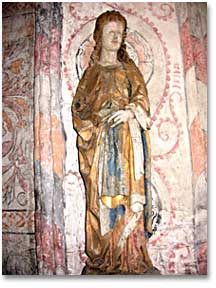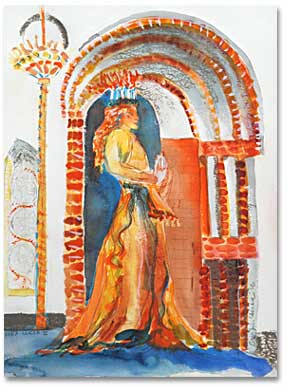|
COVER STORY | IN
THE NEWS | OFF
THE PAVEMENT | ARTBEAT December 7, 2006Vika Luciaby KATHERINE ALMY The days are only a few
hours long at this time of year in Sweden. Living with so little
sunlight must give one a greater appreciation for it. Thus, the
shortest day of the year, when one can look forward to the return
of the sun and eventually warm weather, is cause for celebr "Early in the morning on Dec. 13, Santa Lucia, the Queen of Light, comes into your bedroom. She is a young girl, a daughter, relative or friend of the family, dressed in white, bearing a lighted crown on her head, singing the Lucia song and offering coffee and the traditional Lucia buns." This is how the Swedes celebrate the solstice, as explained to me by artist Claire Iris Schencke. For Swedes throughout the world, it is the start of the Christmas season. For the past three years, Iris has brought this celebration to Arcata in her own way, through her art. At Hank's Coffee Shop, 1602 Old Arcata Road (across from Jacoby Creek School), through January, you can see the latest paintings in her series, Lucia Celebrations. Iris started the tradition in 2004, after a visit to her parents in Sweden. She drew on traditional visual elements such as floral patterns and painted wooden horses, as well as the Lucia figure. The next year's paintings were inspired by a portrait of her mother at age one, who she portrayed in several paintings as a "Tiny Lucia." In keeping with the connection to her family, this year's paintings are inspired by the murals and carved statuary in the church of the village of Vika, near her family's summer home. The church is small and simple, with a clean, whitewashed exterior and an elegant brick archway over the door. Inside, the walls are decorated with intricately patterned murals. The original artwork in the church has suffered the usual battles of fleeting cultural likes and dislikes. The Catholic excesses of the 14th century were whitewashed over in the 17th, and subsequently restored in the 20th. "The painted walls were revealed through a painstaking method involving repeated blotting with loaves of bread," Iris explained. The process left the artworks with the muted quality of antiquity, which Iris replicates in some places; in others, she uses the bright colors that she imagines they were originally, colors that typically predominate in her paintings. The brilliant colors and sensual curves of her Santa Lucia break through all of the stereotypes of Swedish austerity. Iris told me that her love of bright colors may have been influenced by the few years she lived in Mexico, but I suspect there's more to it than that. The warm colors and her bold use of them come from within and reflect her personality, as does the humor in her work.
The paintings are about the Santa Lucia celebration, which is ostensibly Christian, but with overlays from more ancient traditions that are more at the heart of Iris's intentions. Santa Lucia is a very early Medieval Italian saint, recognized for her kindness and generosity. Her name, derived from the Latin word lux, meaning light, connects her to the celebration of the return of the light at the Solstice. "As always in these traditions," Iris explained, "there is a great deal of confusion as to the origin, and all the Swedish Yule traditions contain this mix of Paganism, a veneer of Catholicism and modern secular interpretations." For Iris, the celebration is about "light, friends and good food." The young woman bringing food and drink represents generosity and the lights she wears remind everyone that the long, warm days are coming to balance out the dark of winter. Seeing these paintings and talking with Iris got me thinking about what I enjoy about the holidays: being with family, the warm hearth of a friend's house, cooking favorite dishes, the smell of the kitchen, sharing a good meal. This is some of what Iris brings to us from Sweden through her paintings. So here is your opportunity to take a break from the hectic holiday rush. Go to Hank's with a friend, enjoy a cup of coffee and take in the warm colors of Iris' paintings. For a more direct encounter with St. Lucia, the local Scandinavian community's Balder Lodge No. 343 has its annual St. Lucia Day Celebration at the Odd Fellows Hall at 239 Buhne St. in Eureka (near Williams St.) on Dec. 16, starting at 7 p.m. And if you'd like to experience the flavor of this Swedish celebration, here's a recipe for Lucia buns. If you want to have your daughter bring them to you on the morning of the 13th, though, do keep this in mind: Even though the tradition calls for a wreath of lit candles, the modern Swedes use battery operated ones for safety. God Jul!
Got a local exhibit or art event that might make a good story? Send your art news to almy@arcatanet.com or write in care of the North Coast Journal, 145 South G Street, Suite A, Arcata, CA. 95521. COVER STORY | IN
THE NEWS | OFF
THE PAVEMENT | ARTBEAT Comments? Write a letter! © Copyright 2006, North Coast Journal, Inc. |


 ation.
ation. While
Iris also uses pastels, hand-made papers and other mediums, she
works primarily with watercolors, since she prefers their fluidity
and their unpredictable nature. Watercolor paints have a mind
of their own, and Iris capitalizes on that, giving the medium
a measure of control over the direction of the final painting.
The result is loose and ethereal, but grounded by the rich colors
and textures.
While
Iris also uses pastels, hand-made papers and other mediums, she
works primarily with watercolors, since she prefers their fluidity
and their unpredictable nature. Watercolor paints have a mind
of their own, and Iris capitalizes on that, giving the medium
a measure of control over the direction of the final painting.
The result is loose and ethereal, but grounded by the rich colors
and textures.